In this post you will find the insectivorous plant example and their detailed explanations.
Insectivorous plants are those that trap and consume animals or protozoans, such as insects and other arthropods. Photosynthesis is still used by insectivorous plants to generate some energy.
Some Insectivorous plant examples are discussed below:
- Venus flytrap
- Pitcher plant
- Drosera
- Common butterwort
- Drosophyllum
- Pinguicula
- Utricularia
- Genlisea
- Byblis
Venus flytrap
The Venus flytrap (Dioanaea muscipula) is a carnivorous flowering plant. The plant consist of two leaf like hinged lobes which act as a trap for the insects. Hair like projections are present which are called Trichomes. These trichomes induce the lobes to immediate closing when prey comes in touch with it.

- This type of movement is known as Thigmonasty.The lobes will only shut if the trichomes present on it is being touch by the prey for many times. This action will prevent the plant to lose its energy when there is no insect.
- The hinge has tiny bristles at the edge, so that once the prey is trapped, it cannot escapes out.
- This insectivore plant eats all kinds of insects and arthropods to gain nutrition but also derives nutrition from soil. It can kill all flying insects, spiders, grasshopper, ants etc.
- This plant can digest any creature within 3-5 days and can survive for months without eating.
Pitcher plant
Pitcher plants (Sarracenia) are carnivores having jug-shaped morphology with modified leaves which act a lid of the jug. Leaves close the open hollow part of the plant and act as pitfall trap. Main body is filled with fluids which digest the prey once get trapped. Plant use the nectar to attract the insects, once the insect enter the deep chamber get drowned and digested.

- Members of the Nepenthaceae and Sarraceniaceae groups are referred to as “pitcher plants.”
- The edge of the hollow part which is called peristome becomes wet, it secretes nectar and produces anthocyanin colors by which insect get into the trap.
- Pitcher plants may also have waxy scales and projecting aldehyde crystals that insects can’t climb out of. The small fluid bodies are embedded within the pitcher plant called Phytotelmata that submerge the insect, causing its body to disintegrate over time.
- Enhanced viscoelasticity is linked to higher insect retention, which can aid in the capture of flying insects like flies, while increased fluid acidity reduces insect dying time, which can help in the capture of crawling insects like ants.
Drosera
Drosera, they are also known as sundews. It is one of the largest genera of carnivorous plants. These Droseraceae members use stalked mucilaginous glands on their leaf surfaces to attract, capture, and consume insects. The insects are utilised to compensate the plants’ lack of mineral nourishment in the soil. Every continent except Antarctica is home to a variety of species that differ significantly in size and form.
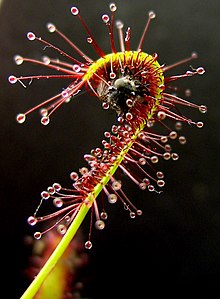
D. capensis has strap-like leaves that can grow to be 3.5 cm long and 0.5 cm broad. The brightly colored tentacles of all sundews release a sticky mucilage that captures arthropods. The plant blooms in the summer (December and January in its native South Africa) with up to 50 pale violet, 2 cm wide flowers carried on up to 35 cm tall racemose inflorescences. When the blooms close, they can self-pollinate and generate a large number of minute, spindle-shaped seeds, which are released from capsules that form when the flowers die. This plant grows well on full sunlight and nutrient depleted environment having damp and lime restricted soil.
Common butterwort
Common butterwort is a plant that feeds on insects. Its bright yellow-green leaves release a sticky fluid that attracts insects; once caught, the leaves gently curl around and consume their victim.
Example of common butterwort is Pinguicula vulgaris which carnivore perennial. It is 3-16 cm long and having a funnel shaped purple flower which is 15mm longer. White flower can also be seen but its rare.
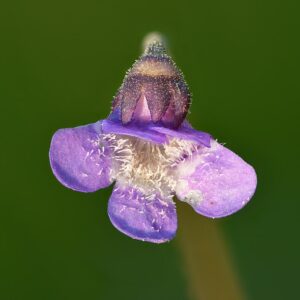
This butterwort can be found in bogs and swamps, as well as low and subalpine elevations.
It has glands on its leaves that secrete a sticky substance that captures plants on the leaves, as well as digestive enzymes that function to digest insects externally. Because they typically thrive in acidic, low-nutrient soil, such as bogs, this allows the plant to reach a supply of nitrogen.
Drosophyllum
The genus Drosophyllum has only one species, Drosophyllum lusitanicum (Dewy Pines). When grown outside, these fascinating plants produce a unique honey scent to attract prey and are always covered with the black carcasses of unfortunate insects. They have beautiful yellow flowers.
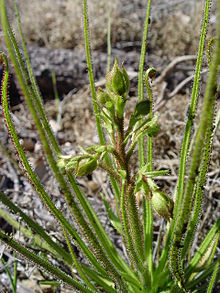
The plant has a characteristic sweet scent that attracts the insects it feeds on. Insects gets stuck to the mucilage released by the stalked glands on the leaves when they strike on them. The more the insects resist, the more entrapped they become, eventually dying to suffocation or fatigue. Enzymes are secreted by the plant which digests the prey or insect and releases the nutrients which is then absorbed by the plant. These nutrients are used by the plant to replace the nutrient-deficient soil in which it thrives.
Pinguicula
Pinguicula, or butterworts, are carnivorous flowering plants belongs to the family of Lentibulariaceae . To supplement the low mineral nutrition they get from the environment, they use sticky, glandular leaves to attract, capture, and digest insects.
Tropical butterworts either create compact winter rosettes of fleshy leaves. They are usually found in areas where water is scarce throughout the year, as overly wet soil can lead to rotting. They’re found in regions where, due to acidic soil conditions, nitrogenous supplies are known to be scarce, rare, or absent.
Butterwort leaf blades are smooth, stiff, and juicy, and are usually bright green or pinkish in color. The leaves size ranges from 2-30cm in accordance with species. The shape of the leaf varies per species, but it is commonly obovate, spatulate, or linear. The leaves can also be yellow in appearance, with a velvety texture and greasy consistency.
Utricularia
They are called bladderworts and belongs to the genus of carnivorous plants. Different species of Utricularia are found on different continents of terrestrial, fresh water and damp soil areas but cannot found on Antarctica region.Utricularia are carnivorous and use bladder-like traps to catch small organisms.
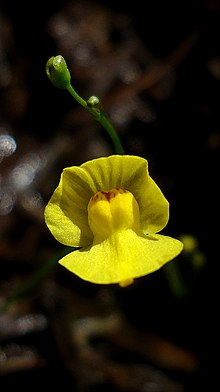
Terrestrial species have tiny traps that feed on microscopic food like protozoa and rotifers that swim in water-soaked soil. Utricularia gibba is a small to medium-sized aquatic plant that can be free-floating in the water column, or attached to the substrate in shallow water but it will flower more if supported by a substrate beneath shallow water.
Genlisea
Genlisea are often called corkscrew plants. They are little herbs that grow from a short rhizome and have two leaf types: photosynthetic foliage leaves and highly adapted subterranean leaves that capture insects.
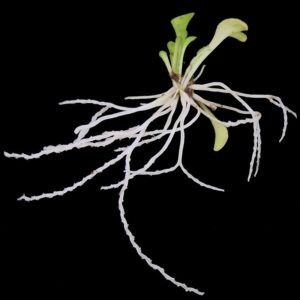
The plants attract, trap, and digest little micro-fauna, especially protozoans, using highly modified subterranean leaves. Although the plants lack roots, the subterranean traps fulfil many of the same tasks as roots, such as anchoring and water and nutrient absorption.
Byblis
Byblis is a tiny genus of carnivorous plants known as the rainbow plants because of its colourful mucilage-covered leaves in intense sunlight. It possesses sticky hairs that attract insects by tricking them into thinking the glandular secretions are nectar drops.
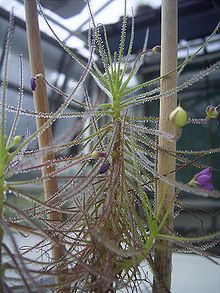
Byblis, on the other hand, differs from the sundew in that its hairs do not wrap around the trapped prey. Byblis aquatica has main axis of stem which is not further branched and fine fibrous root like structure are attached to the main axis.The core stem can grow to be 45 cm long. The entire length of the leaf is coated with stalked mucilaginous glands. These not only attract and capture insect prey, but they also allow the plant to “hold fast” on nearby objects for support. Flowers emerge singly at the terminal of 1.5–3 cm stalks that look similar to leaves.
Also Read:
- Denitrifying bacteria examples
- Endonuclease enzyme example
- Mesophilic bacteria examples
- Fibrous protein function
- Transmembrane proteins function structure
- Non capsulated bacteria
- Diffusion pressure
- Cofactor examples
- Hypotonic solution examples
- Plant cell vs animal cell

Hi, I am Saif Ali. I obtained my Master’s degree in Microbiology and have one year of research experience in water microbiology from National Institute of Hydrology, Roorkee. Antibiotic resistant microorganisms and soil bacteria, particularly PGPR, are my areas of interest and expertise. Currently, I’m focused on developing antibiotic alternatives. I’m always trying to discover new things from my surroundings. My goal is to provide readers with easy-to-understand microbiology articles.
If you have a bug, treat it with caution and avoid using antibiotics to combat SUPERBUGS.
Let’s connect via LinkedIn: